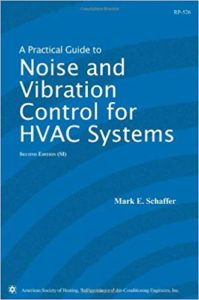A Practical Guide to Noise and Vibration Control for HVAC Systems
A Practical Guide to Noise and Vibration Control for HVAC Systems
A Practical Guide to Noise and Vibration Control for HVAC Systems provides information for engineers, architects, contractors and other building industry professionals who have little or no experience with acoustical terms or concepts. Presents practical design guidelines to help minimize the possibility of excessive HVAC system noise and vibration in and around buildings, and by suggesting investigation methods to help solve existing noise and vibration problems.
As a result, the HVAC community has become much more sensitive to the acoustical design of its products and systems. Many equipment manufacturers are producing quieter products and sometimes use the acoustical benefit as the primary marketing
feature. Increased attention to product acoustical performance is evidenced by the fact that the number of HVAC acoustical testing laboratories has almost doubled since 1991. Also, increased internationalization has permitted access to low-noise HVAC products from Europe and Asia.
You can also read Know and Understand Centrifugal Pumps
A Practical Guide to Noise and Vibration Control for HVAC Systems Content
- Preface
![Noise and Vibration Control for HVAC Systems]()
- Acknowledgments
- Introduction
- General Design Guidelines
- Airside Equipment
- Water-Side Equipment
- Packaged and Unitary Equipment
- Vibration Isolation
- Specifications
- Construction Phase Tasks
- Troubleshooting Noise and Vibration Complaints
- A:Some Basics of HVAC Acoustics
- B:Acoustical Rating Systems and Criteria
- C:Measuring HVAC System Noise
- D:Using Manufacturers’ Sound Data
- E:Definitions and Abbreviations
- F:Addresses of Agencies and Associations
- G:Bibliography and Selected References
Over the past few decades, building design teams have become more aware of the potential noise and vibration problems from HVAC systems. Mechanical engineers are specifying sound traps (duct silencers), acoustical louvers, sound-absorbing duct liners, and vibration isolators, while architects are designing mechanical room walls and slabs with high sound transmission class (STC) ratings. Despite the addition of these noise and vibration control features in more and more building designs, complaints of excessive HVAC system noise and vibration are still common. Investigations into these complaints by acoustical professionals have
found that, in many cases, the correct equipment and materials were used, but they were not properly integrated into a quiet system, or some seemingly insignificant detail was omitted that negated the expected acoustical benefit.


Comments are closed.